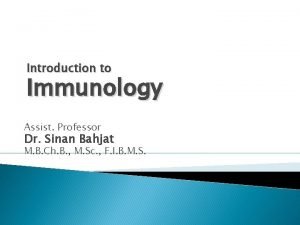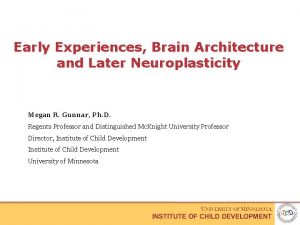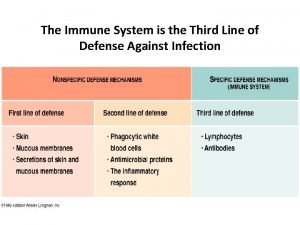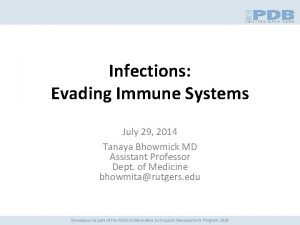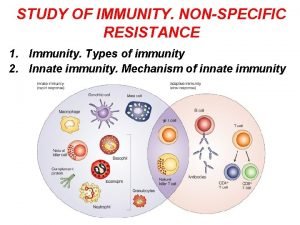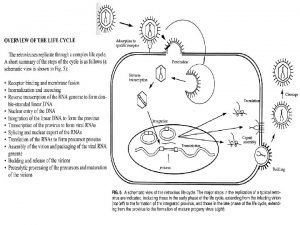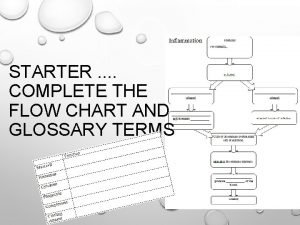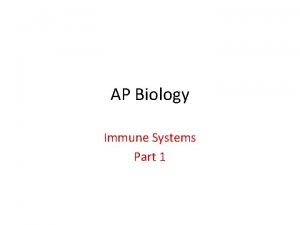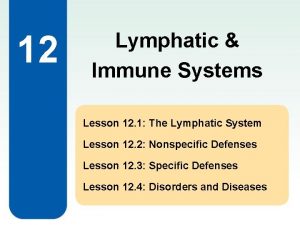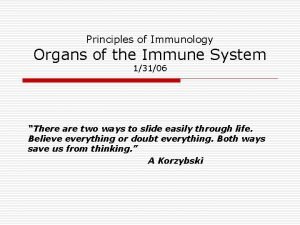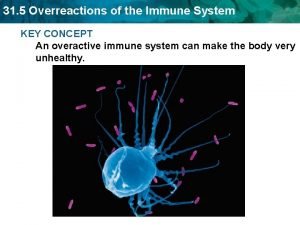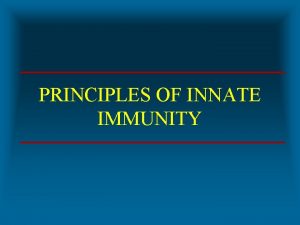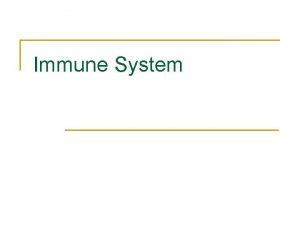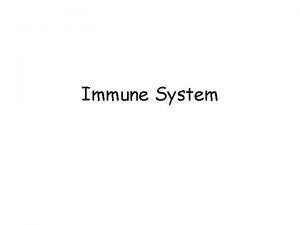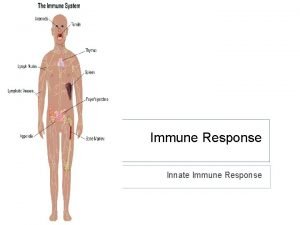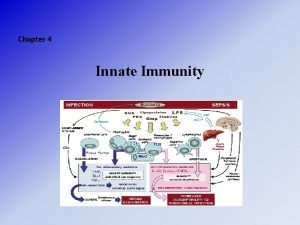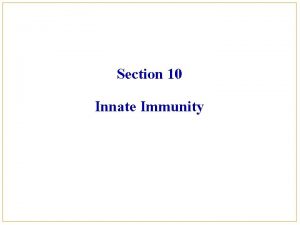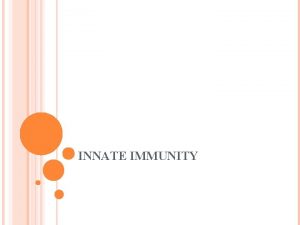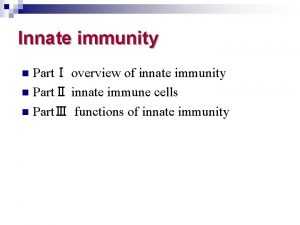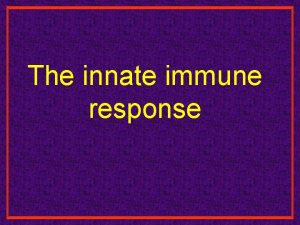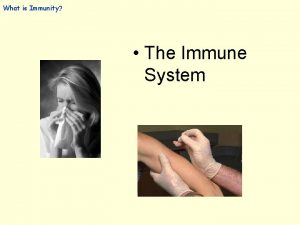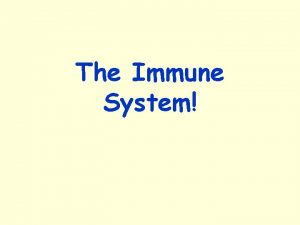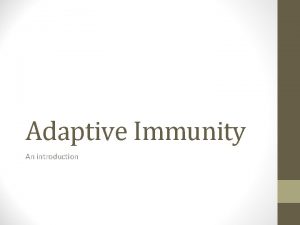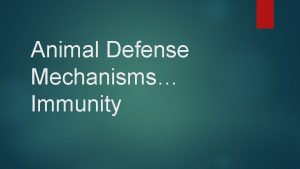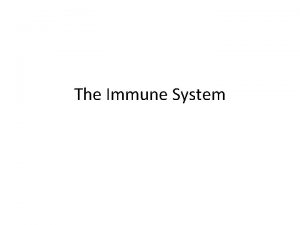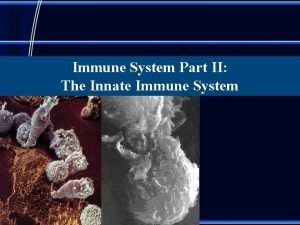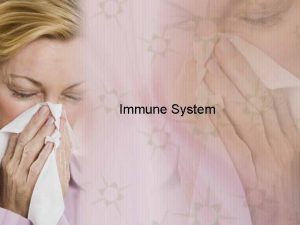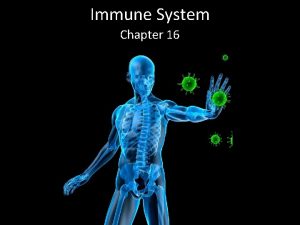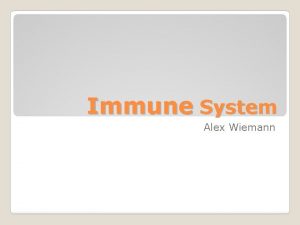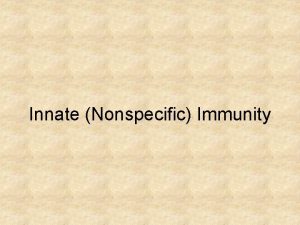Immune System Innate Immunity Innate immunity preprogrammed defense


























- Slides: 26

Immune System

Innate Immunity • Innate immunity – pre-programmed defense responses.

Barrier Defenses • Skin and mucus • Oil, sweat (low skin p. H)

Internal Defense • Macrophages – engulf pathogens • Interferons – proteins secreted by infected cells that signal neighboring cells to defend themselves.

Internal Defense • Inflammatory Response – pain and swelling that occur upon injury or infection. • Mast cells – hold histamines that cause blood vessels to dilate, bringing extra blood which causes swelling in the tissues. • This attracts phagocytes to come and help deal with the infection.

Internal Defense • Natural killer cells – destroy infected or cancerous cells

Acquired Immunity • Acquired immunity – a defense response that is enhanced by previous exposure to the pathogen.

Lymphocytes • • Lymphocytes – white blood cells B – cells mature in the bone marrow T- cells mature in the thymus White blood cells fight infection, but each has a specific job

Recognition • Antigen – a foreign molecule that is recognized and gets a response from lymphocytes. • Antigen receptors – receptors found on lymphocytes that recognizes the epitopes of antigens • -antibody / immunoglobulin (Ig) – a soluble form of the antigen receptor that can be secreted by the B-cell.


Recognition • Major histocompatibility complex (MHC) – an infected cell protein that displays a fragment of the antigen for white blood cells to recognize. • Class I – found in most cells, and calls cytotoxic Tcells that use toxins to kill the infected cell • Class II – found in dendritic cells and macrophages, which are called antigen presenting cells. They use Class II MHC’s to call helper T- cells that assist other lymphocytes.


Clonal Selection • Clonal selction – cloning of lymphocytes in response to a binding an antigen • When exposed to an antigen a B or T cell will divide rapidly making effector cells to attack and memory cells to store incase of future invasion.


Primary Immune response • The clonal selection is the primary immune response it peaks about 10 to 17 days after infection.

Secondary immune response • Upon another exposure to the same antigen, the reserved memory cells are called upon in greater numbers. The response peaks 2 -7 days after exposure and last longer.

Lymphocyte Types • B – cells – secrete antibodies to bind to antigens in the blood or lymph. • Cytotoxic T-cells – secrete proteins that kill infected cells. They must be signaled by helper T- cells and/ or MHC molecules • Helper T cells – activated by antigen presenting cells (class II MHC) and release cytokines to call upon B and T cells to act.

Humoral Response • Humoral response – clonal selection of B cells. Usually fights pathogens not in cells yet. ** • The antibodies secreted can neutralize pathogens or make them targets for phagocytes.

Cell Mediated Response • Cell mediated response – cytotoxic T-cells destroy infected cells. **

Helper T-Cells • Can call for B-cells and T-cells to act. **


5 antibody classes

Antibody Affects **

Immunization • Active immunity – secondary response • Passive immunity – antibodies passive from mother to fetus can cause a secondary like response the first time a fetus is exposed to infection. (Passed across the placenta(Ig. G) and breast milk (ig. A)) • Vaccination – introducing an antigen into the body to elicit clonal selection.

Allergies • Allergies – exaggerated responses to antigens. Can trigger mast cell to elicit a an inflammatory response.

Autoimmune disease • Sometimes the immune system turns against certain molecules naturally in the body. • Lupus- against DNA histones in breaking down cells. • Rheumatoid Arthritis – against cartilage
 Difference between acquired immunity and innate immunity
Difference between acquired immunity and innate immunity Innate immunity first line of defense
Innate immunity first line of defense Second line of defense immune system
Second line of defense immune system Innate immunity first line of defense
Innate immunity first line of defense Innate immunity first line of defense
Innate immunity first line of defense Cell lysis complement system
Cell lysis complement system Tonsil histology
Tonsil histology Primary immune response and secondary immune response
Primary immune response and secondary immune response What is the third line of defense in the immune system
What is the third line of defense in the immune system Any substance capable of provoking an immune response
Any substance capable of provoking an immune response Primary vs secondary immune response
Primary vs secondary immune response First line of defense
First line of defense Assis prof
Assis prof Innate immunity examples
Innate immunity examples Neutrophil extracellular traps
Neutrophil extracellular traps Innate immunity
Innate immunity Innate immunity
Innate immunity 3 lines of defense immunity
3 lines of defense immunity Th and tc cells
Th and tc cells Immune system flow chart
Immune system flow chart Chapter 35 immune system and disease
Chapter 35 immune system and disease Ap bio immune system
Ap bio immune system Lesson 12.1 lymphatic ducts and vessels
Lesson 12.1 lymphatic ducts and vessels Lesson 12 blood and immune system
Lesson 12 blood and immune system Immune system lymph nodes
Immune system lymph nodes Define immunity
Define immunity Overreactions of the immune system
Overreactions of the immune system

